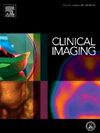Colorectal liver metastases on gadoxetic acid-enhanced MRI: Typical characteristics decrease after chemotherapy
IF 1.8
4区 医学
Q3 RADIOLOGY, NUCLEAR MEDICINE & MEDICAL IMAGING
引用次数: 0
Abstract
Purpose
To determine to what extent colorectal liver metastases (CRLM) display typical imaging characteristics on gadoxetic acid-enhanced magnetic resonance imaging (MRI) and what changes after chemotherapy.
Methods
We retrospectively identified 258 patients with a gadoxetic acid-enhanced MRI between 2015 and 2021 and pathologically proven non-mucinous adenocarcinoma CRLM. 722 unique CRLMs were analyzed: 378 CRLM in only the chemotherapy-naïve analysis; 217 in post-chemotherapy analysis; and 127 CRLM were analyzed both pre- and post-chemotherapy. The following six characteristics were defined as typical; “hypovascular”, “unenhanced T1-weighted (UE-T1W) hypointensity”, “arterial rim enhancement”, “non-enhancing during hepatobiliary phase”, “T2-weighted (T2W) mild hyperintensity”, and “diffusion restriction”.
Results
All six typical characteristics were found in 249/505 chemotherapy-naïve CRLM (49 %) and 87/344 post-chemotherapy CRLM (25 %). The occurrence of some typical characteristics decreased post-chemotherapy: UE-T1W hypointensity 485/505 (96 %) versus 311/336 (93 %), arterial rim enhancement 291/498 (58 %) versus 154/301 (51 %), T2W mild hyperintensity 478/505 (95 %) versus 269/338 (79 %), and diffusion restriction 435/497 (87 %) versus 200/306 (65 %). Almost all metastases showed a hypovascular appearance, both in the chemotherapy-naïve (495/504, 98 %) and post-chemotherapy group (330/331, 100 %). Additionally, all CRLM appeared non-enhancing compared to the liver in the hepatobiliary phase (100 %).
Conclusion
Most CRLM show various combinations of at least five typical characteristics on gadoxetic acid-enhanced MRI. Arterial rim enhancement is the least prevalent characteristic both in chemotherapy-naïve and post-chemotherapy patients. Post-chemotherapy the occurrence of typical MRI characteristics decreases, especially mild T2W hyperintensity and the presence of diffusion restriction.
求助全文
约1分钟内获得全文
求助全文
来源期刊

Clinical Imaging
医学-核医学
CiteScore
4.60
自引率
0.00%
发文量
265
审稿时长
35 days
期刊介绍:
The mission of Clinical Imaging is to publish, in a timely manner, the very best radiology research from the United States and around the world with special attention to the impact of medical imaging on patient care. The journal''s publications cover all imaging modalities, radiology issues related to patients, policy and practice improvements, and clinically-oriented imaging physics and informatics. The journal is a valuable resource for practicing radiologists, radiologists-in-training and other clinicians with an interest in imaging. Papers are carefully peer-reviewed and selected by our experienced subject editors who are leading experts spanning the range of imaging sub-specialties, which include:
-Body Imaging-
Breast Imaging-
Cardiothoracic Imaging-
Imaging Physics and Informatics-
Molecular Imaging and Nuclear Medicine-
Musculoskeletal and Emergency Imaging-
Neuroradiology-
Practice, Policy & Education-
Pediatric Imaging-
Vascular and Interventional Radiology
 求助内容:
求助内容: 应助结果提醒方式:
应助结果提醒方式:


